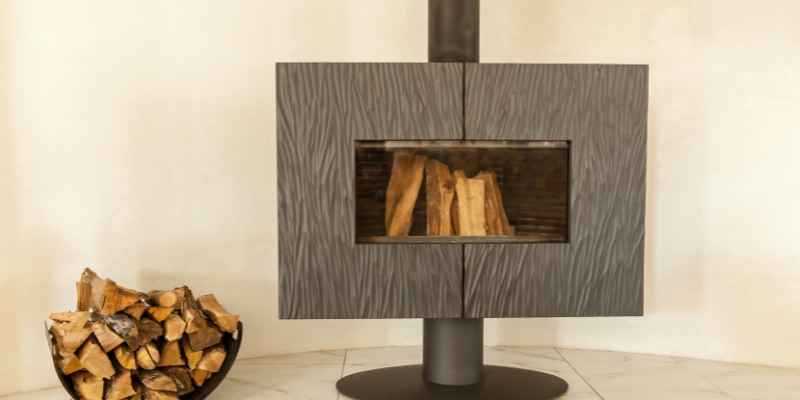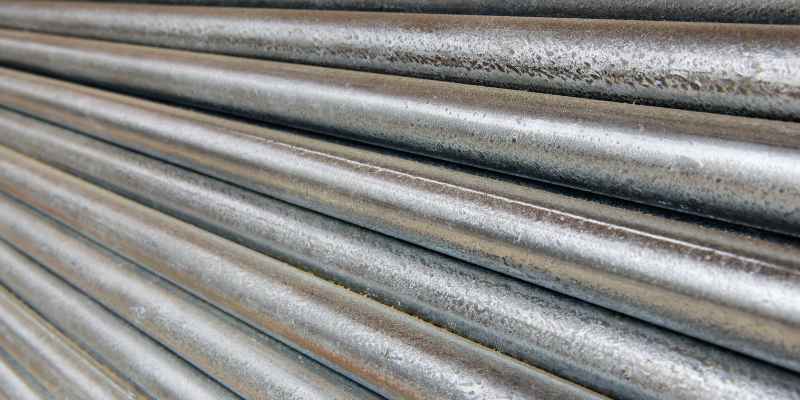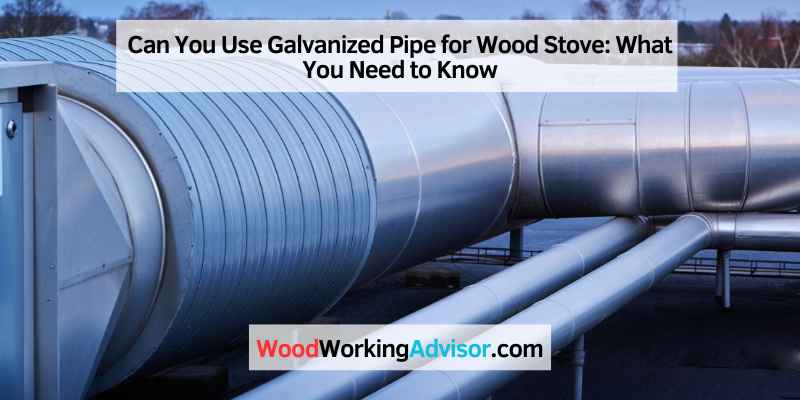Galvanized pipes are not recommended for wood stoves because the high temperatures produced by the stove can vaporize the zinc coating and release toxic fumes into the air. It is important to use Class A chimney pipe, which is designed for wood-burning fireplaces and stoves, when transitioning stove pipe through a wall or ceiling.
The pipe is often referred to as double-wall, triple-wall, all-fuel, or insulated chimney pipe. It is crucial to follow the codes and regulations for wood stoves to ensure safety. We will discuss the safety guidelines when using chimney pipes for wood stoves.
Understanding Your Stove Pipe Requirements
When it comes to stove pipe requirements, it’s important to choose the right materials. While galvanized pipe may be an option for certain applications, it is not recommended for use with a wood stove. Choosing the right type of pipe, such as Class A chimney pipe, is essential for safety and functionality.
Are you getting ready to install a wood stove in your home or cabin? If so, it’s important to understand your stove pipe requirements. The right stove pipe ensures safe and efficient operation of your wood stove. In this blog post, we’ll delve into the different types of stove pipes, including Class A Chimney Pipe, the difference between galvanized and black stove pipes, and the code for wood stove pipes.
Class A Chimney Pipe
Class A Chimney Pipe is designed specifically for wood-burning fireplaces and stoves. It is also used when transitioning stove pipe through a wall or ceiling. This double-wall, triple-wall, all-fuel or insulated chimney pipe is rated to withstand high temperatures and protect your home from the heat of your wood stove.
Difference Between Galvanized and Black Stove Pipes
Galvanized and black stove pipes are two of the most popular types of stove pipes. Galvanized stove pipes are made of steel that has been coated with a layer of zinc to protect it from rusting. Black stove pipes, on the other hand, are painted black to give them a sleek appearance. Black is for looks only, and will rust if exposed to the outdoors. Galvanized, however, will not rust (or will take longer to rust) when exposed to the outdoors.
Code for Wood Stove Pipes
It’s essential to follow code when installing wood stove pipes. Many local codes require the use of Class A Chimney Pipe, as it’s the safest and most efficient option. In addition, it’s important to ensure that any stove pipe passing through a wall or ceiling is properly insulated to prevent heat transfer to combustible materials.
In conclusion, choosing the right stove pipe is crucial for safe and efficient operation of your wood stove. Consider using Class A Chimney Pipe, understanding the difference between galvanized and black stove pipes, and following code when installing your wood stove pipe system.
The Truth About Galvanized Pipes
Galvanized pipe should never be used for a wood stove as welding creates high temperatures that vaporize zinc and pose a safety risk. Instead, Class A chimney pipe is used for wood-burning fireplaces and stoves and is often referred to as double-wall, triple-wall, all-fuel, or insulated chimney pipe.
Why You Shouldn’t Use Galvanized Pipes For Wood Stoves
Using galvanized pipes for wood stoves is one of the most common mistakes that people make. Galvanized pipes are not suitable for wood stoves because they are coated with a layer of zinc, which can cause serious health hazards. The zinc coating on galvanized pipes reacts with the high temperatures generated by the wood stove and releases toxic fumes, including zinc oxide, which can cause serious health problems. It’s important to remember that when it comes to wood stoves, safety should always be your top priority.
The Dangers Of Welding Galvanized Pipes
Welding galvanized pipes is even more dangerous than using them for wood stoves. Welding galvanized pipes creates extremely high temperatures that can cause the zinc coating to vaporize and release toxic fumes, including zinc oxide and other harmful chemicals. Inhaling these fumes can cause serious health problems, including respiratory issues and metal fume fever. Welding galvanized pipes can also damage the pipes, making them more susceptible to corrosion and other types of wear and tear.
Alternative Materials
If you’re looking for material to use for your wood stove, there are plenty of safe, alternative options that you can choose instead of galvanized pipes. Some of the most popular materials for wood stove pipes include black stove pipe and stainless steel. Black stove pipe is a popular choice because it is affordable and easy to install.
Stainless steel is a more expensive option, but it is incredibly durable and can last a lifetime with proper care. Other options for wood stove pipes include ceramic and clay pipes, which are known for their high heat resistance. When choosing a material for your wood stove pipes, always make sure to choose a product that is specifically designed for use with wood stoves and that meets all safety standards.
Expert Opinions
Galvanized pipe is not recommended for wood stoves due to high temperatures and potential risks of zinc vaporization. Class A chimney pipe, also known as insulated chimney pipe, is typically used for wood-burning fireplaces and stoves as it is made of double or triple-walled stainless steel.
It is important to follow the correct installation codes and guidelines for safety and efficiency.
The Pros And Cons Of Different Types Of Stove Pipes
When it comes to installing a wood stove, one of the most critical decisions you will make is what type of stove pipe to use. There are several varieties to choose from, all with different advantages and disadvantages. Black stove pipe is the most common choice for indoor use but will rust if installed outside. In contrast, galvanized pipe does not rust but can be harmful if used to connect to a woodstove.
Stainless steel offers high external durability and retains the heat inside. Double and triple-wall insulated chimney pipe replaces the need for additional insulation, and Class A chimney pipe is used for wood-burning fireplaces and stoves.
Manufacturer Recommendations
Many stove manufacturers recommend specific types of stove pipes that should be used for their stoves. The manufacturer’s recommendations should always be your first priority because they know better about their products. Installing a non-recommended stove pipe can result in voiding the manufacturer’s warranty and serious safety issues. Manufacturers typically recommend specific types of stove pipes based on the stove’s size, heat output, and venting needs, so be sure to carefully follow the manufacturer’s instructions when selecting a stove pipe.
Chimney Sweep Advice
Chimney sweeps typically recommend using Class A chimney pipe when installing a wood-burning stove. They strongly advise not using galvanized metal for stove pipe because it can release toxic gases that can harm you and your family’s health. When selecting a stove pipe, you should consult a professional chimney sweep to ensure that you are using the appropriate materials and following the safety guidelines.
In conclusion, when it comes to installing a wood stove, you need to consider various factors before choosing the right stove pipe. Remember that the manufacturer’s recommendations and chimney sweep’s advice should always be at the forefront of your mind. Because the wrong choice of a stove pipe can have serious health, safety, and warranty implications, it is incredibly important that you carefully consider your options before making a decision.
Installing Your Wood Stove

Using galvanized pipe for wood stoves is not recommended because the high temperatures can vaporize the zinc coating and release harmful fumes. It’s best to use double-wall insulated chimney pipe specifically designed for wood-burning stoves to ensure safety and compliance with code requirements.
Selecting the Right Stove Pipe Material
One of the most important aspects of installing a wood stove is selecting the right type of stove pipe material. Stove pipes are available in different materials like galvanized, stainless steel, and black steel. While galvanized pipes are suitable for some applications, they are not recommended for wood stove installations. Galvanized pipes are made of steel and coated with a layer of zinc, which can release toxic fumes when exposed to high temperatures. Therefore, it is essential to choose the right type of pipe material to ensure safety while using a wood stove.
Tips for Proper Installation
When installing a wood stove, it is important to follow the manufacturer’s recommendations and local building codes. Here are some tips to ensure proper installation of your wood stove:
– Place the stove on a stable and non-combustible surface like bricks or tiles to prevent it from tipping over.
– Install the stove pipe vertically to ensure the proper draft and avoid blockages.
– Use the right size and grade of pipe for your installation. Consult with a professional if you are unsure of the size and grade of the pipe you require.
– Install a chimney cap to prevent debris and pests from entering your chimney.
– Install a smoke detector and carbon monoxide detector in the same room as the wood stove. This ensures you’re alerted if there is any danger.
Ensuring Safety
When installing a wood stove, it is essential to ensure safety not only for the occupants of the home but also for the people in the surrounding area. Here are some safety measures to follow to make sure that your wood stove does not cause any harm:
– Ensure you have a sufficient supply of air for your stove to prevent the build-up of toxic gases.
– Have the chimney inspected regularly to ensure it is free of blockages that could cause carbon monoxide buildup.
– Keep the area around the wood stove clear of combustible materials like fabrics, furniture, and curtains that could ignite. A safe zone of 36 inches is recommended.
– Use appropriate materials to protect your walls and floor from the heat created by your wood stove.
By following these tips, you can ensure that your wood stove is installed correctly and operates safely. Remember, regular maintenance is the key to enjoying a safe and efficient wood stove.
Maintaining Your Stove Pipe
Using galvanized pipe for a wood stove is not recommended. It is important to use Class A chimney pipe, often referred to as double-wall, triple-wall, all-fuel or insulated chimney pipe, to ensure safety and prevent rusting when exposed to the outdoors.
To ensure your wood stove operates efficiently and safely, it’s crucial to maintain your stove pipe. The stove pipe helps to draw smoke and combustion gasses out of your home, preventing dangerous carbon monoxide buildup. The good news is that maintaining your stove pipe is relatively easy, and a little bit of effort can go a long way in keeping your family safe.
Cleaning and Maintenance Tips
Cleaning your stove pipe is essential to prevent blockages, which can cause smoke to back up into your home. It’s best to clean your stove pipe at least once a year or more frequently if you use your stove often. Here are some cleaning and maintenance tips for your stove pipe:
– Check your stove pipe regularly for signs of soot or creosote buildup. Creosote is a tar-like substance that can ignite and cause a chimney fire.
– Use a stiff wire brush to scrape off any creosote buildup
– Inspect the pipe for any cracks or leaks which may cause smoke leaks or harmful gas leaks
– Ensure that the damper and the stove pipe itself are always open when starting the fire
– Have a professional chimney sweep clean your stove pipe to ensure that it is appropriately maintained.
Common Issues with Stove Pipes
There are some common issues that you should be aware of when it comes to your stove pipe; these include:
– Creosote buildup: As mentioned, creosote is a tar-like substance that can catch fire and lead to a chimney fire.
– Rust: If you have a galvanized stove pipe, rust can compromise the structural integrity of the pipe and lead to leaks.
– Blockages: Debris, soot, and other blockages can cause the smoke and gas to back up into your home.
Replacing Old Stove Pipes
If your stove pipe is old or has visible damage, it’s best to replace it with a new one. Here are some tips to consider when replacing your stove pipe:
– Determine the right size: Ensure that you purchase the right size stove pipe for your wood stove to ensure that it fits correctly and functions well.
– Choose the right material: Black stove pipes are usually made of plain carbon steel, and they can rust easily. Galvanized stove pipes, on the other hand, are plated with zinc and are corrosion-resistant. However, they can still emit harmful fumes when heated.
– Hire a professional: They can help you choose the right materials, install it correctly and ensure that it is safe for your home.
In conclusion, maintaining your stove pipe is essential to ensure that your wood stove operates safely and efficiently. Regular cleaning and maintenance can prevent soot and creosote buildup and help you catch any potential problems before they turn into a significant issue. If you’re unsure about maintaining or replacing your stove pipe, it’s always best to consult with a professional.

Frequently Asked Questions For Can You Use Galvanized Pipe For Wood Stove
What Kind Of Pipe Do You Use For A Wood Stove?
Class A chimney pipe, also known as double-wall, triple-wall, all-fuel or insulated chimney pipe, is commonly used for wood-burning fireplaces and stoves. It is appropriate for transitioning stove pipe through walls or ceilings and is insulated to protect against heat and combustion byproducts.
Avoid using galvanized pipe, as it may release toxic fumes at high temperatures.
What Is The Difference Between Galvanized Stove Pipe And Black Stove Pipe?
Black stove pipe is solely for aesthetic purposes and will rust when exposed to outdoor elements. Galvanized stove pipe will not rust or take longer to rust when confronted with outdoor conditions. Therefore, galvanized stove pipe is a better option for wood stoves.
Can You Use Steel Pipe For Wood Stove?
No, steel pipe should not be used for wood stove. It is recommended to use Class A chimney pipe, which is double-wall, triple-wall, all-fuel or insulated chimney pipe, for transitioning stove pipe through a wall or ceiling and for wood-burning fireplaces and stoves.
Galvanized pipe should not be used for wood stove as welding at extremely high temperatures can vaporize zinc.
What Is Code For Wood Stove Pipe?
Code for wood stove pipe refers to the regulations set by the National Fire Protection Association (NFPA) for the installation of wood stoves and their venting systems. It includes specific guidelines for the type of chimney or stove pipe to use, minimum clearances to combustibles, and installation of firestops.
It is important to follow these codes to ensure safe and efficient wood stove operation.
Conclusion
To conclude, using galvanized pipe for wood stoves is a subject of much discussion in the market. While some people do use it, galvanized pipe is not the best material for wood stove pipes. It is because the high temperature may vaporize the zinc coating, releasing toxic fumes into the room.
Therefore, it is wise to use Class A chimney pipe, which is specifically designed for wood-burning stoves and is much safer. Remember, the safety of you and your family should always come first.


